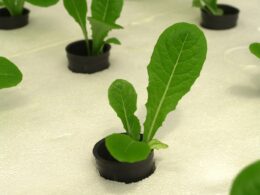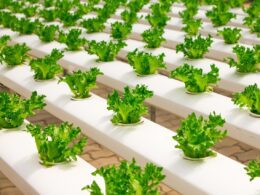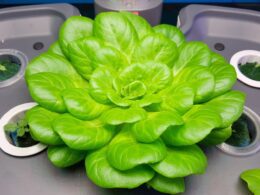Are you tired of dealing with unsightly algae in your aquarium or pond? Algae growth can not only make your water look unappealing, but it can also harm the health of your aquatic life. While there are chemical solutions on the market, you may be hesitant to use them due to concerns about potential harm to your fish and plants.
Fortunately, there are natural methods for reducing algae that are both safe and effective. In this article, we’ll explore several ways to naturally reduce algae in your water. By following these simple steps, you’ll be able to keep your aquarium or pond looking clean and clear without resorting to harsh chemicals.
From regular water changes and filter cleanings to introducing beneficial bacteria and controlling nutrient levels, there are plenty of strategies you can implement to keep your aquatic environment healthy and algae-free. So, let’s dive in and discover how you can effectively manage algae growth in your water.
Conduct Regular Water Changes and Filter Cleanings
To keep your aquatic environment clean and free of unwanted green growth, make sure to regularly change the water and clean your filters. This is one of the easiest and most effective ways to reduce algae in your fish tank.
By conducting regular water changes, you’re removing excess nutrients that algae feed on, such as nitrates and phosphates. Additionally, cleaning your filters will help remove any debris that can also contribute to algae growth.
There are several benefits of water changes and filter maintenance beyond just reducing algae. Regular water changes can help maintain a healthy pH level and prevent the buildup of harmful chemicals in the water. Cleaning your filters also helps improve water quality by removing waste and debris that can harm your fish.
It’s important to note that the frequency of water changes and filter cleanings will vary depending on the size of your tank and the number of fish you have.
When it comes to cleaning your fish tank filter, it’s important to follow the proper steps to ensure it’s done correctly. First, turn off the filter and unplug it from the power source. Then, remove the filter media and rinse it with aquarium water to remove any debris. Use a soft-bristled brush to gently scrub the filter components, being careful not to damage them.
Once everything is clean, reassemble the filter and restart it. By following these steps, you can ensure that your filter is working properly and helping to reduce algae in your tank.
Introduce Beneficial Bacteria
Using beneficial bacteria can be a great way to optimize the health of your aquatic environment and keep it balanced. These bacteria strains work to break down organic waste and other harmful substances in the water, which can reduce the amount of algae that grows.
Here are some benefits of using beneficial bacteria:
- They can reduce the need for harsh chemicals to treat your aquarium or pond.
- They help to maintain a healthy biological balance in the water.
- They can improve the overall health and well-being of your aquatic creatures.
- They are easy to use and don’t require any special equipment.
- They can be used in both freshwater and saltwater environments.
There are many different types of aquatic bacteria strains available, each with its own specific benefits. Some of the most common strains include:
- Nitrifying bacteria, which convert harmful ammonia into less harmful nitrates.
- Denitrifying bacteria, which convert nitrates into nitrogen gas that can be released into the atmosphere.
- Beneficial bacteria, which help to break down organic waste and reduce the amount of algae that grows in the water.
By introducing these beneficial bacteria into your aquarium or pond, you can create a healthy environment that is less susceptible to algae growth. This can help to keep your aquatic creatures healthy and happy, while also reducing the amount of time and money you need to spend on maintenance. So if you’re looking for a natural way to reduce algae in your aquatic environment, consider using beneficial bacteria.
Can Algae in a Hydroponic System Be Harmful to Plants?
Algae in hydroponic systems can indeed be harmful to plants. While some algae growth is natural and beneficial in small amounts, excessive growth can lead to issues. Algae can compete with plants for nutrients and light, potentially causing stunted growth or even suffocation. Proper maintenance, like maintaining light levels and using algae inhibitors, is crucial to prevent the harmful effects of algae in hydroponic systems.
Add Aquatic Plants
Adding aquatic plants is a great way to promote a healthy and balanced aquatic environment, while also enhancing the aesthetic appeal of your aquarium or pond. Aquatic plants help reduce algae by competing with them for nutrients, light, and space. This means that the more aquatic plants you have, the fewer nutrients are available for algae to thrive. Additionally, aquatic plants release oxygen during the day and absorb carbon dioxide, which helps to oxygenate the water and maintain a healthy pH level.
There are many aquatic plant benefits that can help reduce algae in your aquarium or pond. Some of the best aquatic plants for reducing algae include water hyacinths, water lilies, and duckweed. Water hyacinths grow quickly and absorb large amounts of nutrients, which can help prevent algae growth. Water lilies provide shade to the water, which can reduce the amount of light that reaches the algae, and duckweed helps to block sunlight and absorb nutrients.
By adding aquatic plants to your aquarium or pond, you can enjoy a healthier, more balanced aquatic environment while also reducing algae growth. Not only do aquatic plants help to reduce algae, but they also add beauty to your space and provide a natural habitat for fish and other aquatic creatures. So, why not consider adding some aquatic plants to your aquarium or pond today and enjoy the many benefits they have to offer?
Control Nutrient Levels
Maintaining balanced nutrient levels is key to keeping algae growth under control in your aquarium or pond. Here are some tips for controlling nutrient levels:
-
Test your water regularly: This will help you keep track of the nutrient levels in your aquarium or pond and make adjustments accordingly. You can purchase a water testing kit at your local pet store or online.
-
Balancing pH: Algae thrives in water with a high pH level. Make sure to keep your pH levels between 6.5 and 7.5. If your pH levels are too high, you can add a pH decreaser to bring it down.
-
Reduce phosphorus levels: Phosphorus is a nutrient that promotes algae growth. You can reduce phosphorus levels in your aquarium or pond by limiting the amount of fish food you give your fish or by using a phosphate remover.
-
Avoid overfeeding: Overfeeding your fish can lead to excess nutrients in your aquarium or pond, which can promote algae growth. Make sure to only feed your fish what they can eat in a few minutes and remove any uneaten food.
By controlling the nutrient levels in your aquarium or pond, you can naturally reduce the growth of algae. This will not only make your aquarium or pond look more aesthetically pleasing, but it’ll also create a healthier environment for your fish and other aquatic life.
Remember to test your water regularly, balance your pH levels, reduce phosphorus levels, and avoid overfeeding your fish to keep algae growth under control.
Use Natural Algaecides
If you’re looking for natural algaecides to keep your pond or aquarium clean, there are a few options you may want to consider.
Vinegar and lemon juice are both acidic substances that can help kill off algae. Barley straw and tea can also be effective, as they contain compounds that prevent algae growth.
For a more intense treatment, you may want to try hydrogen peroxide or saltwater baths.
Vinegar and Lemon Juice
You can try using vinegar or lemon juice to get rid of those pesky algae in your pond or aquarium. Both are natural and effective ways to reduce algae without harming your fish or plants.
Here are some benefits of vinegar for aquariums and lemon juice as an algae deterrent:
-
Vinegar:
-
Helps to balance the pH level in your aquarium water.
-
Can help to remove hard water stains or buildup on aquarium equipment.
-
Acts as a natural algaecide by reducing the amount of nutrients in the water that algae feed on.
-
Lemon Juice:
-
Contains citric acid, which is toxic to algae.
-
Can be used as a spot treatment for small areas of algae growth.
-
Has a fresh scent that can help to mask any unpleasant odors in your aquarium.
So, next time you notice algae taking over your pond or aquarium, consider using vinegar or lemon juice as a natural and safe way to reduce the growth. Just remember to use them in moderation and test the pH levels regularly to ensure a healthy environment for your aquatic pets.
Barley Straw and Tea
Using barley straw and tea can be a simple and effective solution for controlling algae growth in your pond or aquarium. Barley straw contains certain compounds that can help prevent the growth of algae.
You can either add barley straw directly to the water or make DIY barley straw bundles. These bundles can be placed in a mesh bag and then submerged in the water. As the water flows through the mesh bag, the barley straw releases the compounds that help to control algae growth.
In addition to barley straw, you can also use barley tea to help reduce algae in your pond or aquarium. The benefits of barley tea are similar to those of barley straw. Simply brew the barley tea and then add it to the water.
You can also use the tea to soak the DIY barley straw bundles before placing them in the water. By using these natural methods, you can reduce the amount of algae in your pond or aquarium without using harmful chemicals.
Hydrogen Peroxide and Saltwater Baths
Now that you know about the benefits of using barley straw and tea to reduce algae growth, let’s talk about another effective method. Hydrogen peroxide treatment and saltwater dips are particularly useful when you’re dealing with stubborn algae that won’t go away with traditional methods.
Hydrogen peroxide treatment involves adding a small amount of hydrogen peroxide to your pond or aquarium. This will help to oxidize the algae, making it easier to remove. You’ll want to be careful when using this method, as too much hydrogen peroxide can harm your aquatic plants and fish.
Saltwater dips, on the other hand, involve removing your plants and fish from the water and placing them in a saltwater solution for a short period of time. This will help to kill any algae that may be attached to their bodies. It’s important to note that not all plants and fish can tolerate saltwater dips, so be sure to do your research before attempting this method.
Frequently Asked Questions
What are some common signs of algae overgrowth in a fish tank or pond?
If you have a fish tank or pond, it’s important to keep an eye out for common signs of algae overgrowth. These may include discolored or cloudy water, a slimy film on surfaces, or an unpleasant odor.
While algae may seem harmless, it can have harmful effects on aquatic animals, such as depleting oxygen levels and releasing toxins.
To keep your aquatic pets safe and healthy, it’s important to address algae overgrowth as soon as you notice it.
Can algae be harmful to fish or other aquatic animals?
Algae overgrowth in fish tanks or ponds can have negative effects on the health of aquatic ecosystems, beyond just fish or other animals. Excessive algae can reduce oxygen levels and create dead zones that harm the entire ecosystem.
Prevention strategies can include reducing nutrient levels in the water through proper feeding, changing water regularly, and adding plants or algae-eating animals to the tank or pond. Additionally, controlling light exposure and temperature can help inhibit algae growth.
By taking proactive steps to prevent algae overgrowth, you can help maintain a healthy and safe aquatic environment for all inhabitants.
How long does it typically take for aquatic plants to start reducing algae in a tank or pond?
If you’re looking to reduce algae in your tank or pond, consider adding aquatic plants to your water.
Aquatic plant growth can help to naturally reduce algae over time, but the timeline for seeing results can vary depending on a few factors, such as the species of plants you choose and the size of your tank or pond.
Generally, it can take anywhere from a few weeks to a few months to start seeing a noticeable reduction in algae growth. However, it’s important to remember that aquatic plants require proper care and maintenance to thrive, so be sure to do your research and provide them with the necessary nutrients and lighting to ensure their success.
Are there any particular types of beneficial bacteria that are more effective at reducing algae growth?
If you’re looking to reduce algae growth in your tank or pond, beneficial bacteria can be a great natural solution. Some types of beneficial bacteria are more effective at reducing algae than others. For example, bacteria that consume excess nutrients like nitrates and phosphates can starve algae of the resources it needs to grow. Additionally, bacteria that produce hydrogen peroxide can help control algae growth by creating an environment that is unfavorable to algae.
Incorporating these types of beneficial bacteria into your aquatic environment can be an effective way to naturally reduce algae growth and keep your tank or pond looking healthy and clean.
What are some alternative methods to reducing algae growth, aside from those mentioned in the article?
Looking for natural ways to reduce algae growth in your outdoor pond? There are a variety of methods available, including both DIY and store-bought options.
One popular option is the use of barley straw, which can be purchased in bales or in liquid form. Another effective method is the use of aquatic plants, which compete with algae for nutrients and sunlight.
Additionally, proper maintenance of your pond, including regular cleaning and removing debris, can go a long way in preventing algae growth. By taking a proactive approach to pond maintenance and utilizing natural algae reduction methods, you can enjoy a clear and healthy pond all season long.
Conclusion
In conclusion, you can naturally reduce algae in your water. To keep your water clean and healthy, remember to conduct regular water changes and filter cleanings. This will help remove excess nutrients that contribute to algae growth.
Introducing beneficial bacteria can also help break down organic matter and prevent algae blooms. Additionally, adding aquatic plants to your water can help absorb excess nutrients and provide shade to reduce sunlight exposure.
Remember to control nutrient levels by avoiding overfeeding and using natural algaecides as a last resort. By following these simple steps, you can enjoy a clear and healthy aquatic environment.









